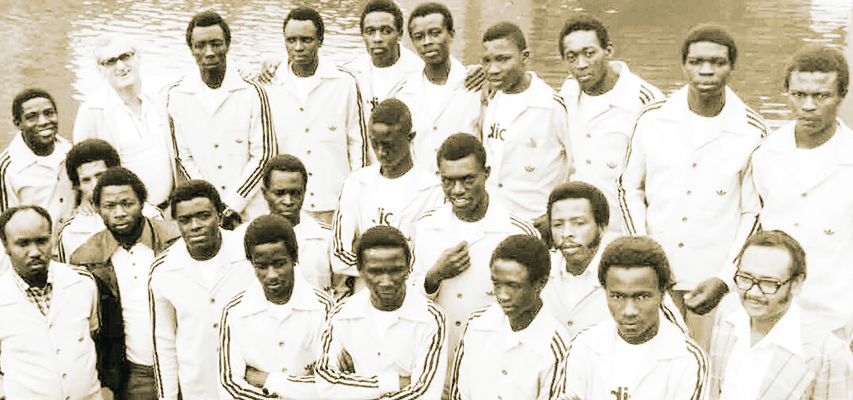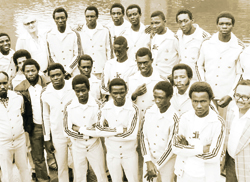
Elijah Lidonde was Kenya’s best striker of the late1940s and across the ‘50s. A huge, broad-shouldered man with a powerful right foot, he was a permanent feature for Nakuru and the Kenya national team whose successes and failures in the Gossage Cuphe was part of, for about 10 years. His fame fired the imagination of younger players, one of whom was Joe Kadenge, who told me the only place he ever wanted to go was Nakuru, to put wings to his fledgling career in Maragoli.
It could only be Nakuru with its concentration of players from Western Kenya. Nakuru also ran Kenya’s most competitive league of that day.
It wasn’t by coincidence that independent Kenya’s first league champions were Nakuru All Stars. But it has to be noted that the league took place throughout 1963, before independence on December12. The Cup was awarded on December 18, but that league is officially recorded as the newly-free country’s first. The run-down town may now be filthy, congested and draining its effluent in what should be its most precious resource, Lake Nakuru. But it was not always like this.
Established by British colonial settlers in 1904 and acquiring municipality status in 1952, Nakuru was acclaimed as the cleanest town in East Africa in the period preceding the end of the 1970s. It was a beautiful town with trees lining its every streets. The pre-independence era was marked by racial segregation. African football was played at the 8000-seat Afraha Stadium, then known as Nakuru Stadium, which was built in1948 and which still remains the town’s main sports centre today. Whites used the exclusive Rift Valley Sports Club. Even then there were racial interactions as illustrated by this 1950 report:
A draw was a very fair result in the inter-racial soccer match between Nakuru African XI and Caledonians, watched by a large mixed crowd at the Nakuru Stadium on Sunday afternoon. The teams were very evenly matched and despite far too frequent patches of scrappy midfield play, most of the sixty minutes was played at a keen pace for a beginning-of-the-season match. The tally of goals should have been higher, and would have been had the visiting Europeans shown better finishing in the target area and if the Africans had kept out of the offside trap set for them. Both goals were gained by the left wing men. Robert, an eat attacker for the Africans, seized the opportunity of an open goal in the 4thminute and slammed home a blockbuster. Dicker equalized twelve minutes later with a fine shot which swerved in from the corner flag.
On February 7, 1950, the Nakuru Municipal African Affairs Officer, J.H. Mandefield, gave what would be called today a state of the county sports report. A story published in the East African Standard on that report, part of which is excerpted below, is illuminating:
Because of the successful record of one of the teams in the Nakuru African Football Association, the Association is without a cup for the coming season’s cup competition and urgently needs a trophy to replace the Nakuru Cup. The original Nakuru Cup was presented to the Nakuru African Football Association by Mr David Campbell, the secretary of the Rift Valley Sports Club, and was open to all teams in the Nakuru district. Bunyore team, however, exercised a monopoly on the Cup, Mr. J.H. Mandefield, (Nakuru Municipal African Affairs Officer) told the East African Standard. And having won it seven years in succession, Mr. Campbell agreed that they should hold it forever. Will some generous person perpetuate his interest in organized African sport by ensuring that a Nakuru Cup will be available for competition this season? The new trophy will continue to bear the same name as its predecessor. The performances of Bunyore, in winning the Nakuru Cup and of Mumias, in winning the Crewe-Read Cup were most praiseworthy, commented Mr. Mandefield, in his annual report, for both teams were at the bottom of their respective leagues, Mumias without having won a game.

The Nakuru football team, too, created an “incredible record” and, says Mr Mandefield,“it was a great disappointment that they were unable to crown a magnificent season by winning the Remington Cup.” Nakuru were beaten by North Nyanza in the final by3-0 and the disappointment was made greater by the fact that Nakuru had defeated North Nyanza by 6-2 in a previous match.
Out of 14 matches played, Nakuru won 13 and lost one; only 18 goals were scored against them during the season while their sharpshooters gained 68.
After commenting on “the highlight of all events” in African sport in Nakuru in 1949 –the Kenya Athletic Championships – Mr. Mandefield reports that badminton, volley ball and tennis “all had enthusiastic followings throughout the year.” Since badminton was introduced last year it has become very popular with the African and a fair efficiency has been attained, he told the East African Standard. Nakuru Africans are anxious to tryout their new-found skill in a match against the Goans but first would like some hints and instruction from an expert. The African Affairs Officer would be glad to hear from any lover of the game willing to give an hour or so of his time every week.”
